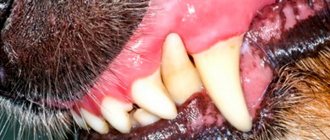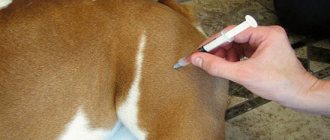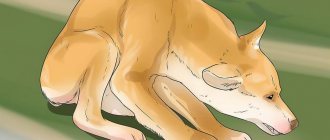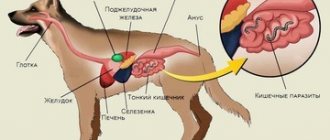A cold in dogs is an acute, respiratory, or viral infection or disease. Many dog owners rarely experience symptoms of colds, because most of them live in comfortable conditions. The apartments are always warm, the diet is balanced, and the owners often buy a variety of vitamin complexes. This does not mean that the animal will not get sick. Risk is always present.
Colds in dogs are a serious infection.
Colds may not seem serious to many, but remember that even a minor infection will become bacterial and cause serious complications or lead to the death of your pet.
Colds can develop in any animal, regardless of breed and age, but at the same time, the risk of infection increases in small or adult dogs, as well as pets with impaired immune systems. There are certain risk zones, and in order to understand whether your pet is included in them or not, it is important to carefully consider the provocateurs that develop the disease, learn about the symptoms of the disease and effective treatment methods.
Possible causes
Animal immunity works like a clock, and basically, it copes with the first manifestations of viral or bacterial diseases. You may not notice it at all. As a rule, the dog feels absolutely healthy after just 24 hours, and the only symptom that accompanies the disease is.
In this case, there is a lack of cheerfulness or complete indifference, which is difficult not to notice. However, if the animal has a bad pedigree, is kept in inappropriate conditions, or has experienced severe stress, there is a risk of a more complex cold in the dog.
Factors that provoke a cold:
1. Genetic code. Small breed dogs have a rather unprotected gene pool, which is directly reflected in the poor functioning of the immune system. This may explain the predisposition to various colds;
2. Age. Over the years, the functioning of systems in the body begins to deteriorate in pets. That is why it is important to pay maximum attention to the immune system. Over the years, the animal needs even more care, improving its diet and living conditions;
3. Overcooled. During a long walk in sub-zero temperatures, under torrential downpour, the dog may become hypothermic. In these cases, his body is temporarily unable to carry out thermoregulation. An animal can get even the most minimal hypothermia when exposed to a draft or in a room with a low temperature. Such incidents most often occur with dogs of small breeds; they have elevated normal body temperatures;
4. Falling into an ice snowdrift. In this case, it is forbidden to self-medicate - you should immediately take the animal to a veterinary clinic;
5. The rules for the care and maintenance of the dog are strictly violated. This factor has many features. It consists of a complete diet, providing the pet with its own habitat and rest, it should be warm, comfortable and dry, the optimal microclimate and air humidity should be maintained in the room. Even if one of the factors is disrupted, this can cause a deterioration in the functioning of the immune system, which will lead to illness (including colds);
6. Contact with animals that are already sick. It makes sense that communication is extremely important for a pet. Most dog owners prefer hanging out together. But if you have information that one pet from the group has not received the necessary vaccinations or is already sick, it is better to stop such contact. It is recommended to limit communication with stray pets as much as possible;
7. Parasites, which may not manifest themselves for a long time, will not directly cause a rise in temperature or a runny nose. But, they have a detrimental effect on the immune system, making it vulnerable to various diseases. This is why pet owners need to be tested for helminths once a season;
8. The animal leads a sedentary lifestyle. This is why his immune system becomes vulnerable to various viruses;
9. Allergies. The immune system actively fights allergens, and the body becomes more vulnerable to viruses living in the environment;
10. Cardiac pathologies and mechanical damage in the lung area.
Treatment
Treatment of colds is symptomatic, since there are no effective drugs for viral diseases. Rest is the best medicine, so make sure your beloved dog has a quiet, calm and warm place to recuperate, as well as plenty of food.
Depending on the animal's clinical condition, the veterinarian may administer several medications. One of them is an antipyretic drug. Its goal is to reduce temperature. If your dog has a wet cough, an expectorant (mucolytics) may be appropriate to relieve the unpleasant symptoms by thinning the mucus. Your veterinarian may also prescribe anti-inflammatory medications for your dog.
A dog that has a cold has a weak immune system , so a viral infection is often accompanied by a bacterial infection. Manifests, among others, purulent discharge from the nose or conjunctiva. In these situations, your veterinarian may consider it appropriate to give you an antibiotic that kills or inhibits the growth of bacteria.
Dehydration and malnutrition, which are possible complications of the common cold, may require veterinary attention. Subcutaneous or intravenous fluids containing electrolytes and glucose may be required.
© shutterstock
For dogs with respiratory failure and severe wheezing, oxygen therapy may be prescribed. It consists of allowing the dog to breathe air with a high oxygen content using a special chamber, oxygen collar, mask or tubes.
If your dog is immunocompromised, gets sick often, or has severe cold symptoms, it's worth asking your veterinarian about immune-boosting medications.
Development of various tumors
Many pet owners are interested in the possibility of their pets contracting colds from humans. Alas, it is impossible to find confirmation or refutation of this theory.
A cold occurs as a result of a virus attack, which neutralizes the body's immune system in its own ways and characteristics. Human strains are not dangerous. But, at the same time, this disease can cause the development of a bacterial infection. A pet is also at risk, just like a person.
Cold symptoms
If you don’t know “how to treat a dog for a cold,” initially pay attention to the first symptoms of the disease.
Signs that indicate a cold in dogs appear a few days after infection. Below is a general sequence of a typical appearance.
1. First of all, it is recommended to pay attention to the animal’s nose and be sure to touch it. If it is dry and warm, this is an alarming sign, which signals a deterioration in the pet’s condition and an increase in body temperature.
2. If this symptom is detected, it is important to measure body temperature using a special thermometer for the animal. Dog owners should remember that standard 36.6 applies only to humans and not to animals. Temperature indicators depend on the size of the animal; their indicators fluctuate.
3. A cold in dogs has a characteristic symptom of deterioration in the general condition of the pet - clouding of the coat.
4. Then the so-called behavioral symptoms appear. The pet begins to get tired faster, apathy and passivity arise. He prefers to sleep instead of actively playing, and also gets tired instantly while walking with his owner, does not play at all and refuses to eat.
5. Another obvious symptom of the presence of colds is the appearance of mucus from the eyes and nose. When a dog has a cold, the discharge may not be cloudy or have foreign formations. The presence of blood, purulent exudate or foamy formations in them signals more dangerous diseases.
6. Classic cold symptoms: coughing or sneezing is a way to clear the airways. Owners should also pay attention to the presence or absence of sneezing. Discharge from a cold cannot form a crust. Cough is a more dangerous symptom and signals the presence of viral diseases and the possibility of their spread.
7. Fever and malaria. With a strong increase in temperature, the pet develops chills (this can manifest itself by searching for any thermal zone). This indicates that the cold has become acute, and from now on it should be treated by a qualified doctor. All signs should not cause panic, they are not fatal. However, dog owners should pay attention to the progress of the dog's cold and the general condition of the pet.
Disease progression
If the clinical signs of a cold begin to progress, the animal weakens or, conversely, begins to behave unreasonably aggressively, you should immediately consult a doctor (instant aggression indicates the onset of a viral attack against the background of a pathological disease).
A cough or nasal discharge does not necessarily mean your dog has a cold; it could be an allergy symptom. Do not try to make your own diagnosis, much less prescribe antibiotics, consult a professional. Incorrect diagnosis and illiterate treatment will cause serious complications, which will worsen the pet’s condition and aggravate the problems.
If pus is discharged from the eyes or nose, there is a possibility that this is not a cold, but a manifestation of an acute natural focal infectious disease. In this case, any improper treatment can cause death.
How to treat a cold in an animal?
If the first symptoms of the disease appear, it is rational to immediately begin treatment. But there is no need to postpone your visit to the clinic; a competent doctor will conduct all examinations and collect important tests. This is the only way to eliminate dangerous diseases, and he will also advise how to cure the animal.
If you do not start fighting viruses or infection in a timely manner, complications in the functioning of the kidneys or heart may occur. A quick start to cold treatment will undoubtedly alleviate his condition in the shortest possible time.
Initially, it is worth observing a competent regime of activity and passivity of the pet. It is important for the dog to be in a warm apartment or house where it is regularly ventilated and provided with access to drinking water. In order for treatment to proceed as quickly as possible, it is recommended to reduce walking time to a minimum. From the moment of emptying, you should immediately return home.
Typically, pharmacological treatment is carried out using such drugs.
Take active ingredients:
- "Amoxiclava" - 500 mg once every 24 hours for a week;
- “Cycloferon” - intramuscular injections of 1 ml every 48 hours, for a week in a row;
- "Gamavita" - intramuscular injections, every 24 hours for a week;
- "Ambrobene" - tablets 2 times every 24 hours for a week;
- "Linexa" - 1 capsule 2 times every 24 hours for two weeks;
You can draw up a treatment plan yourself, but it is still recommended to discuss it with your doctor. It is better to take the veterinarian’s opinion as a basis, who will prescribe individual treatment and select the correct dosage.
If your pet has a fever, he is prescribed antipyretics; both Paracetamol and Analgin are suitable. One tablet will help an adult pet, and 1⁄2 will cure a small one. As a general tonic and expectorant, the animal can be given a decoction of special herbs; they are added to drinks.
Veterinary drugs and home remedies
The veterinarian will conduct a clinical examination:
- auscultation of the heart,
- auscultation of the lungs,
- control of mucous membranes,
- palpation of the throat and larynx area,
- palpation around the lymph nodes.
If the diagnosis needs to be expanded, blood draws and stool tests or chest x-rays may be recommended.
If your dog has a cold, the doctor will give you the necessary medications and vitamins. You can use :
- non-steroidal anti-inflammatory drugs,
- vitamin C,
- immunostimulating drugs,
- antibiotics,
- steroidal anti-inflammatory drugs.
Medicines are selected according to the condition of the four-legged animal, age and concomitant diseases. Treatment for bronchitis or pneumonia is more difficult than for a minor upper respiratory tract infection. However, steroid medications are not recommended in puppies, as they can interfere with the growth process of young dogs. Steroids are also not recommended for dogs with kidney or liver disease. Doses are adjusted to the dog's weight - different for Yorkies and different for Great Danes.
Medications not intended for use in dogs should under any circumstances be given to your dog. Medicines for people or other animals can be dangerous for your dog. Their administration can lead to poisoning of the body and often death. Therefore, when prescribing any medications for a dog, you should consult a veterinarian.
A dog that has a cold is usually weak, so treatment should be supported by home remedies. Sick four-legged animals should be kept warm, eat a balanced diet and take vitamin supplements. Warm, soft foods can relieve a sore throat. The owner should limit walks and intense play during this time. First of all, the dog needs peace. Coughing can be triggered by barking at your dog, so make sure he is as calm as possible when he has a cold. Limiting the “opportunity” to barking will speed up recovery and improve your pet’s comfort.
conclusions
Mucus from the eyes and nose should be wiped away. It is better to do this with cotton wool or gauze, previously soaked in chamomile infusion or Furacilin. To prevent dryness on the nose from causing cracks, it should be lubricated with baby cream or chamomile oil. This will speed up the healing of pustular wounds.
But it is better to prevent the appearance of the first signs of a cold in a dog by taking precautions that will not allow the animal to catch a cold. If your pet lives on the street and sleeps in a kennel, try to insulate it as much as possible, and in sub-zero temperatures, the animal should be taken home. Do not bathe him in rainy weather, or when it is below zero outside, protect him from drafts.
The diet in the off-season and winter should be maximally fortified with dietary supplements. Preventive measures are the most rational way to prevent the disease and its consequences.
Currently reading:
- Actions to take in case of an epileptic attack and a shaking dog
- The American Cocker Spaniel is an adroit hunter and loyal friend.
- Recommendations for obedience of a dog if it growls
- 5 Main Causes of a Warm, Dry Dog's Nose
Causes of the disease
Colds in dogs can be caused by hypothermia, decreased immunity, a sedentary lifestyle, or bacterial, viral, or fungal infections. Dogs do not get the flu and acute respiratory infections, but they develop rhinitis, laryngitis, pharyngitis, bronchitis, and tracheitis against the background of a cold.
Pleurisy and pneumonia in dogs are much less common and can be caused not only by hypothermia, but also by heart pathologies, the growth of tumors, and inhalation of irritants. This pathology is more often observed in older animals.










